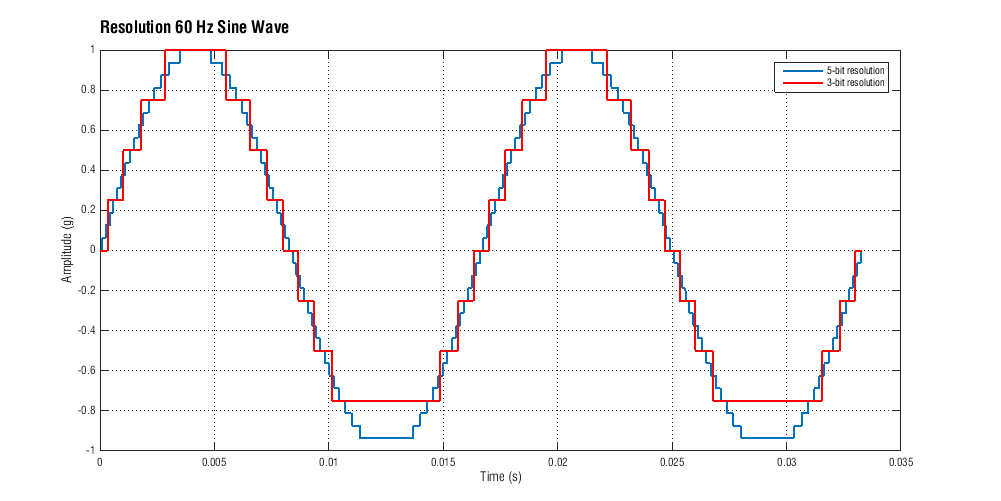How do you choose appropriate data acquisition hardware? To answer this question you really need to scrutinize your vibration measurement application. Ensuring you have the ideal setup for your test environment will help you get meaningful data out of your tests and analysis. Some of the considerations you should make are What kind of sensor am I using? and What filtering capabilities do I need? This blog post will give you an overview of the selection criteria you should consider when evaluating data acquisition hardware for your shock and vibration analysis.
- Sensor Compatibility
- Maximum Sampling Rate
- Measurement Resolution
- Filtering Capabilities
- Additional Resources
Sensor Compatibility
The sensor selection will often dictate what type of data acquisition system is appropriate based upon the sensor’s output. Does the sensor have a digital output? What is the output range? Low sensitivity sensors may require amplification of their output. A data acquisition system that can provide the excitation voltage to power the sensor can eliminate the need for external power supplies, simplifying the measurement system setup significantly.
Maximum Sampling Rate
Best practices call for sampling the signal at a rate 10 times greater than the upper end of the frequency range of interest to capture the vibration profile accurately. For most shock and vibration measurement applications, a data acquisition system requires a sample rate of at least a few thousand hertz, but it all depends on the frequency range of interest. For example, consider the sample of vibration data recorded on a test aircraft shown in Figure 1. The data, which was sampled at 2,500 Hz, is made up of many different frequencies, ranging from 50 to 600 Hz. However, if this same dataset were sampled only at 500 Hz (as indicated by the dashed red line), the vibration environment would appear much different and would be inaccurately represented. General guidelines on the appropriate sample rate are >10,000 Hz for shock testing, >5,000 Hz for general vibration, and ~1,000 Hz for slower vibration or movement.

Figure 1. This vibration data was sampled at 2,500 Hz during a test flight. Sampling at only 500 Hz (the dotted red line) would have produced a misleading representation of the vibration.
Measurement resolution
Resolution is generally specified in bits which can then be used to calculate the resolution in acceleration units. For example, consider an accelerometer system with 16-bit resolution; in other words, it has 216 or 65,536 acceleration levels or bins it can measure. Figure 2 illustrates the importance of resolution on a simple 60 Hz sine wave with two lines of different resolutions. An instrument with 5-bit resolution provides 25 or 32 discrete acceleration levels that can be detected, while 3-bit resolution only provides 23 or 8 discrete levels. Data acquisition systems typically have resolution on the order of 16 or 24 bits. Lower quality shock and vibration data loggers, however, may only have 12-bit resolution or less, which may not be sufficient for some applications.

Figure 2. A 5-bit 1g sine wave (blue) compared with a 3-bit version of the same sine wave (red).
Filtering Capabilities
Filtering removes unwanted frequency content and should be an important part of any evaluation of different data acquisition systems. High-pass filters remove lower frequency vibration and are inherent in all piezoelectric accelerometers (resistor and capacitor in series), which gives these accelerometers the AC response. Analog low-pass filters are crucial to preventing aliasing; once a signal is aliased, it can’t be filtered out digitally in software which can’t be filtered out in software.
An ideal filter would uniformly pass all frequencies below a specified limit and eliminate all above that limit. This ideal filter would have a perfectly linear phase response to the same upper frequency limit. But given that ideal filters don’t exist, some compromise is necessary on a filter’s amplitude and phase response. Four main different types of filters are used:
- A Butterworth filter is known for its maximally flat amplitude response and a reasonably linear phase response. The Butterworth filter is the most popular for vibration measurement.
- The Bessel filter has nearly perfect phase linearity so it is best suited for transient events like shock testing. It has a fairly good amplitude response but its amplitude roll-off is slower than the Butterworth or Chebyshev filter.
- The Chebyshev filter has a faster roll-off in the amplitude response, which is achieved by introducing a ripple before the roll-off. These filters have a relatively nonlinear phase response.
- Elliptic filters have the steepest roll-off in the amplitude response, but they have a ripple in both the pass band and stop band. In addition, their phase response is highly nonlinear. This is only used for applications where phase shift or ringing are not a concern; they also have a tendency to distort complex time signals.
The best filter for a particular application will depend on the application, but in general, the Butterworth filter is best for vibration testing and the Bessel filter is best for shock testing.
Additional Resources
To learn more about data acquisition hardware selection, you can read Strether Smith’s blog post “Sample Rate: How to Pick the Right One.”
I've also written Shock & Vibration Overview which is an eBook that provides a practical overview of the key components of shock and vibration testing including more information on choosing data acquisition hardware. It's available to download as a PDF in the Learn section of our website.
And, of course, don't hesitate to contact us for help in determining the hardware selection criteria best suited to your vibration measurement environment.
